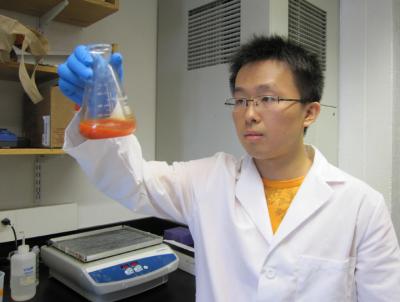Medical implants in the human body often have to combat against Staphylococcus aureus bacteria that form a biofilm on the device. These bacteria are difficult to treat as they are mostly resistant to antibiotics.
 A solution of selenium nanoparticles(Credit: Webster Lab/Brown university)
A solution of selenium nanoparticles(Credit: Webster Lab/Brown university)
A study conducted by engineers at Brown University aims to address this problem by employing selenium nanoparticles as an antibiotic coating on medical devices. Current methods employ silver coating, which is relatively expensive and low on biocompatibility. Results of the study showed that coating polycarbonate catheters and endotracheal tubes with selenium nanoparticles resulted in drastic reduction of cultured population of bacteria, even by as much as 90% in some instances. Apart from being less expensive, selenium is a recommended nutrient for the human body to combat bacteria and is deemed to be harmless at levels formulated in the coatings.
Thomas Webster, senior author of the paper and professor of engineering and orthopaedics, has been studying selenium nanoparticles as potential anticancer material. Webster stated that the selenium coating would give sufficient time for the body’s immune system to fight the bacteria.
As part of the study, Webster’s team grew selenium nanoparticles in two different sizes and coated polycarbonate pieces with the nanoparticle solution. On some pieces, the selenium concentration was degraded by ripping off portions using a tape. Electron and atomic force microscopes were used to measure nanoparticle concentration on both the fully coated and degraded pieces. It was found that smaller particles in the degraded sample adhered to the polycarbonate better than larger nanoparticles. As a final step, the four different samples along with an uncoated control sample were exposed to staph bacteria. Coated samples exhibited drastic reduction in bacteria population after 24, 48 and 72 h. The fully coated pieces of both sizes of nanoparticles showed 90% reduction after 24 h and 85% reduction after 72 h. The degraded sample with smaller nanoparticles fared better than degraded sample with larger nanoparticles. The team is set to commence testing in animals.